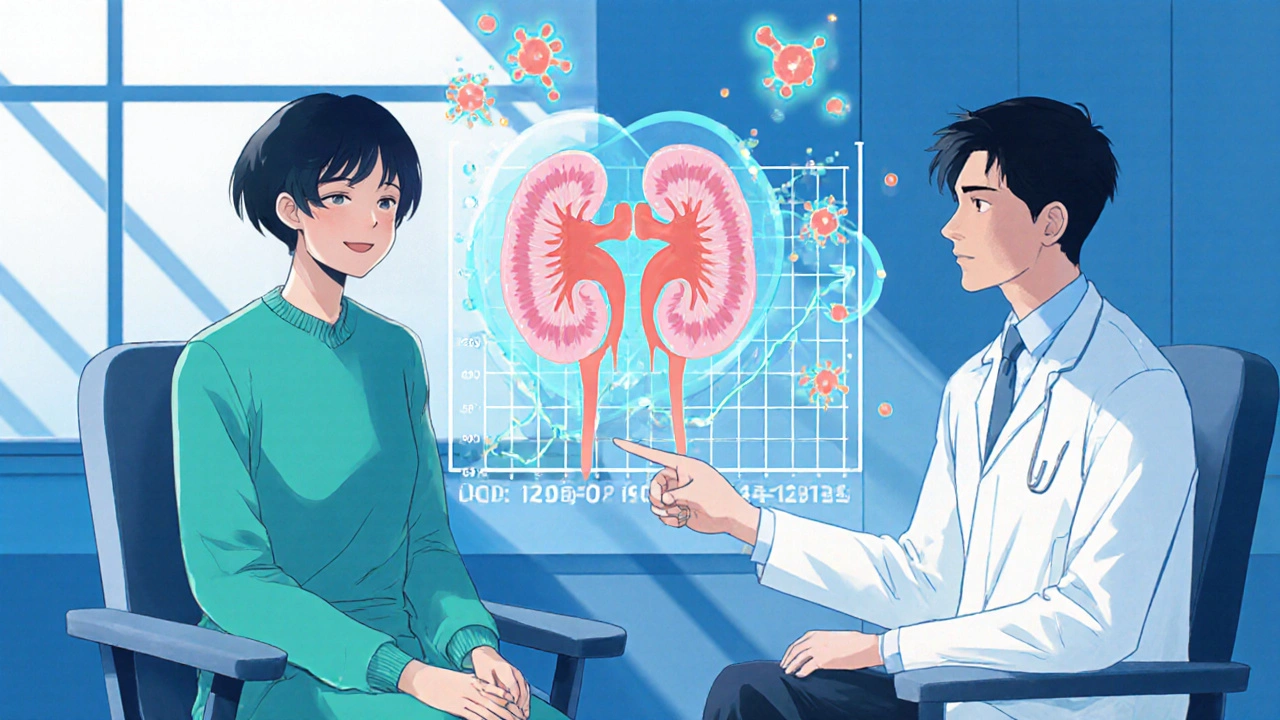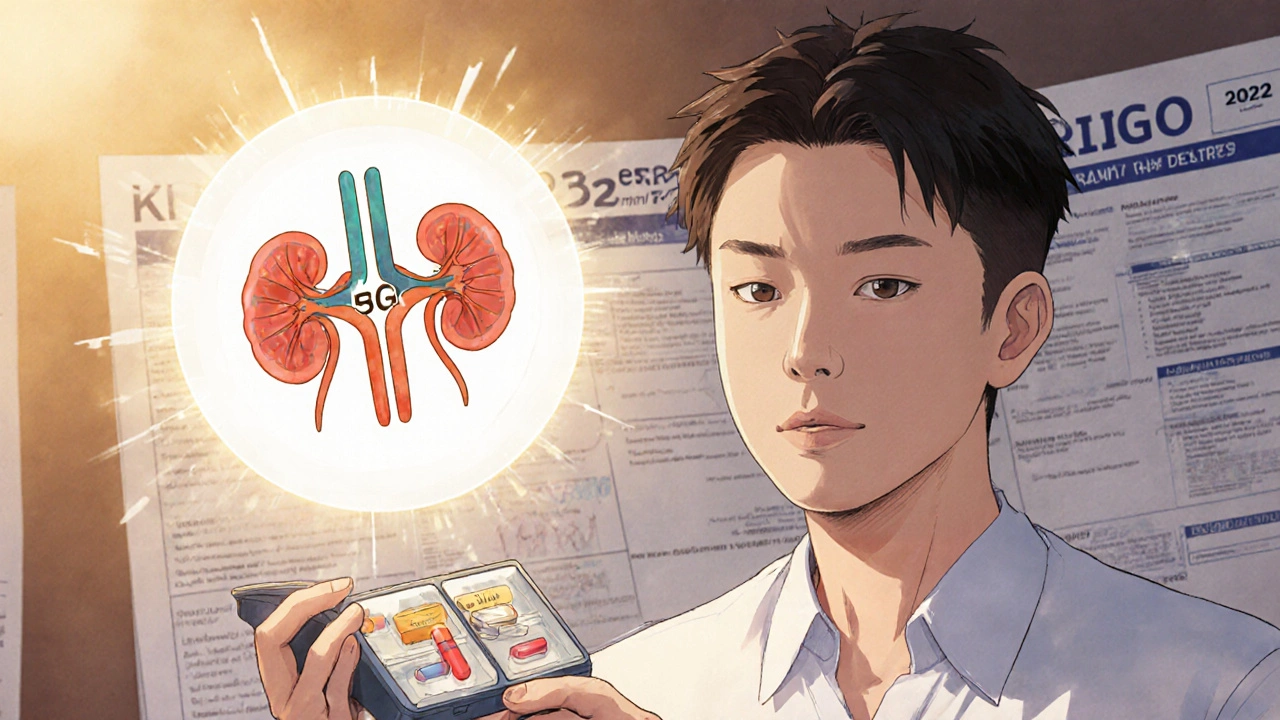CKD Medication Safety Checker
Check safe dosing for metformin and SGLT2 inhibitors based on your eGFR (estimated Glomerular Filtration Rate).
For people with Type 2 Diabetes and Chronic Kidney Disease (CKD), choosing the right medication isn’t just about lowering blood sugar-it’s about protecting the kidneys and avoiding dangerous side effects. Two drugs, metformin and SGLT2 inhibitors, have become central to this balance. But their use has changed dramatically in recent years, and many doctors still follow outdated rules that could keep patients from getting the best care.
Why Metformin Is No Longer Avoided in CKD
For decades, metformin was pulled away from patients with kidney problems because of fears about lactic acidosis-a rare but serious condition where lactic acid builds up in the blood. The old rule? Stop metformin if eGFR drops below 60. Then below 45. Then below 30. But new evidence has turned that thinking upside down.
Today, based on the KDIGO 2022 guidelines and data from over 28,000 patient-years of studies, metformin is considered safe even when eGFR is as low as 30 mL/min/1.73 m². The key is adjusting the dose. If your eGFR is 60 or higher, you can take up to 2,000 mg daily. If it’s between 45 and 59, cap it at 1,000 mg per day. At eGFR 30-44, you still can take metformin-but only 1,000 mg daily, and you need to monitor kidney function more closely.
What’s changed? Research showed that the risk of lactic acidosis isn’t higher in CKD patients using metformin properly. The FDA updated its label in 2016 to reflect this. Now, stopping metformin at eGFR 45 or even 30 is often unnecessary-and it’s actually harmful. Patients who stop metformin unnecessarily lose a drug that reduces heart attacks, strokes, and kidney decline. In fact, the American Diabetes Association now says metformin should be the first drug for most people with Type 2 Diabetes, even with CKD, as long as dosing is adjusted.
SGLT2 Inhibitors: A Game-Changer for Kidney Protection
If metformin is the foundation, SGLT2 inhibitors are the upgrade. These drugs-like dapagliflozin, empagliflozin, and canagliflozin-don’t just lower blood sugar. They slow kidney damage, reduce heart failure hospitalizations, and cut the risk of death from cardiovascular causes.
The biggest shift? You can now start an SGLT2 inhibitor even if your eGFR is as low as 20 mL/min/1.73 m². That’s a huge change from the old limit of 30. The DAPA-CKD and EMPEROR-Preserved trials showed that patients with eGFR between 20 and 30 still got strong kidney and heart benefits. In the EMPA-KIDNEY trial, empagliflozin cut the risk of kidney failure or cardiovascular death by 28% in this group.
And here’s something surprising: you don’t have to stop these drugs if your eGFR drops below 20. The guidelines say you can keep taking them, even if you’re on dialysis. That’s because their benefit isn’t tied to kidney function alone-they work by changing how the body handles fluid and pressure in the kidneys, which helps even when filtration is low.
The lowest effective doses are all you need: 10 mg of dapagliflozin, 10 mg of empagliflozin, 100 mg of canagliflozin, or 5 mg of ertugliflozin. Higher doses don’t give more kidney protection. That’s important because side effects like dehydration and genital infections increase with higher doses.

Side Effects You Need to Watch For
Both drugs are safe when used right-but not without risks.
With metformin, the main danger is lactic acidosis, but it’s extremely rare when dosed correctly. It’s mostly a concern during sudden kidney decline-like after dehydration, infection, or contrast dye scans. That’s why doctors recommend holding metformin during acute illness and restarting only after kidney function returns to normal.
SGLT2 inhibitors bring different risks. About 4-5% of women and 1-2% of men get genital yeast infections. These are treatable but annoying. Staying dry and wearing cotton underwear helps. More serious is the risk of euglycemic diabetic ketoacidosis (DKA)-where ketones rise even though blood sugar isn’t very high. It happens in 0.1-0.2% of users. Signs include nausea, vomiting, belly pain, and unusual tiredness. If you’re on an SGLT2 inhibitor and feel this way, check ketones with a urine strip or blood test, and call your doctor.
Volume depletion is another issue, especially in older adults or those on diuretics. You might feel dizzy when standing, or your blood pressure drops. Drink water, avoid overheating, and don’t skip meals. If you’re on an SGLT2 inhibitor and you’re sick, fasting, or having surgery, your doctor may advise you to pause it temporarily.
Combining Metformin and SGLT2 Inhibitors: The New Standard
The best approach for most people with Type 2 Diabetes and CKD is to use both drugs together. KDIGO 2022 recommends this as first-line therapy when eGFR is 30 or higher. Why? Metformin reduces glucose production in the liver, while SGLT2 inhibitors make the kidneys flush out sugar. Together, they lower blood sugar without causing hypoglycemia-and they protect the heart and kidneys better than either drug alone.
Studies show this combo cuts the risk of kidney failure by 40-50% compared to older regimens. It also reduces hospitalizations for heart failure. And because both drugs are weight-neutral or even cause mild weight loss, they’re ideal for people with obesity, which is common in Type 2 Diabetes.
If you’re already on insulin or sulfonylureas, you may need to reduce those doses. SGLT2 inhibitors lower blood sugar on their own, so adding them without adjusting other meds can cause low blood sugar. The UK Kidney Association suggests cutting sulfonylurea doses by half and insulin by 20% when eGFR is above 45 and HbA1c is under 58 mmol/mol.

Monitoring: What You Need to Track
Using these drugs safely means regular checks.
- For metformin: Check eGFR every 3-6 months. If it’s below 45, check every 3 months. Stop metformin immediately if eGFR drops below 30.
- For SGLT2 inhibitors: Monitor for signs of infection (itching, discharge), dehydration (dizziness, dry mouth), and symptoms of ketoacidosis. Check potassium and creatinine 4 weeks after starting, then every 3-6 months. If you’re also on finerenone (a newer kidney drug), keep potassium under 5.5 mmol/L.
- For both: Avoid contrast dye scans unless absolutely necessary. If you need one, hold metformin 48 hours before and after, and restart only after kidney function is confirmed normal.
Many patients don’t know they need these checks. A 2022 survey found that only 34% of primary care doctors could correctly recall the current dosing thresholds. After a 60-minute training, that jumped to 78%. Education matters-and patients should ask for it.
What’s Next? The Future of CKD Treatment
Research is moving fast. The ZEUS trial is now studying dapagliflozin in patients with eGFR as low as 15 mL/min/1.73 m²-those on the edge of dialysis. Early data suggest it’s safe. The DAPA-CKD-Extension trial is already tracking patients on dialysis, and preliminary results show no increase in serious side effects.
But access is still unequal. A 2023 study found that people with higher incomes were over three times more likely to get SGLT2 inhibitors for advanced CKD than those with lower incomes. Cost, lack of awareness, and provider bias still block many patients from life-changing treatment.
By 2025, we may see SGLT2 inhibitors approved for use even in dialysis patients. The evidence is stacking up. What’s clear now is this: if you have Type 2 Diabetes and CKD, you deserve a treatment plan that protects your kidneys-not one that holds you back out of outdated fear.
Can I still take metformin if my eGFR is 35?
Yes. With an eGFR of 35 mL/min/1.73 m², you can take metformin, but your daily dose should not exceed 1,000 mg. Your doctor should monitor your kidney function every 3 months. Do not increase the dose unless your eGFR improves and your doctor approves it.
Is it safe to start an SGLT2 inhibitor if my eGFR is 22?
Yes. According to the 2022 KDIGO guidelines, SGLT2 inhibitors can be started at eGFR as low as 20 mL/min/1.73 m². You can continue taking them even if your eGFR drops further. The benefits in reducing kidney failure and heart disease outweigh the risks at this stage.
Do SGLT2 inhibitors cause weight loss?
Yes. Most people lose 2-4 kg (4-9 lbs) in the first 3-6 months on an SGLT2 inhibitor. This happens because the drug makes your body get rid of sugar through urine, which also removes extra calories. The weight loss is modest but helpful for blood pressure and insulin sensitivity.
Can I take metformin and an SGLT2 inhibitor together?
Yes. This combination is now the recommended first-line treatment for Type 2 Diabetes with CKD. Together, they lower blood sugar without causing hypoglycemia and offer strong protection for your heart and kidneys. Your doctor may adjust other diabetes meds like insulin or sulfonylureas to avoid low blood sugar.
What should I do if I get a urinary tract infection while on an SGLT2 inhibitor?
Urinary tract infections are not directly caused by SGLT2 inhibitors, but genital yeast infections are common. If you have burning, itching, or unusual discharge, see your doctor. These are usually easy to treat with antifungal creams or oral meds. Don’t stop the SGLT2 inhibitor unless your doctor advises it-stopping it removes the kidney protection.
When should I stop metformin during illness?
Hold metformin during acute illness like severe infection, dehydration, or if you’re having surgery. These situations can cause temporary kidney stress and raise lactic acidosis risk. Restart metformin only after you’re eating normally and your eGFR has returned to your baseline level.

